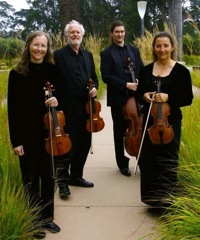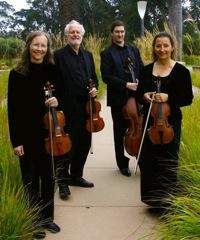For the past three years, this task has been the singular preoccupation of the New Esterházy Quartet, an ensemble comprising several of the Bay Area’s finest period-instrument performers. Founded in 2006, the quartet set as its express goal to complete the Haydn cycle by the end of 2009, the 200th anniversary of the composer’s death. Their penultimate installment, a program called “Le Matin, Le Midi, Le Soir,” offers a panorama of Haydn’s early, middle, and late works, including his quartets Op. 1/0 in E-flat major, Op. 9/4 in D minor, Op. 64/6 in E-flat major, and Op. 103 in B-flat major/D minor. Two afternoon performances Nov. 28-29, in San Francisco and Palo Alto, are followed by a special presentation on Nov. 30 at Berkeley’s Freight and Salvage Coffeehouse (Haydn would be pleased by its ambiance).

The chasm separating desire from realization is often insurmountable, but New Esterházy has demonstrated a laser focus in finishing its appointed task. As its violist, Anthony Martin, observed in an SFCV interview last June, “all string players who love quartets say that they’d love to play all the Haydn Quartets, but violinist Kati Kyme has actually made it happen. Very few have accomplished it, and of those, even fewer have ever done it in public. The New Esterházy Quartet is the only group in America, in this hemisphere even, to have done it on period instruments.”
What is it about the Haydn quartets that make them such hallowed ground? Although it’s highly debatable that Haydn single-handedly invented the string quartet in the mid-18th century, as some have claimed, there’s no denying his status as history’s first great quartet composer. Especially while serving the influential Esterházy family in Hungary, Haydn decisively elevated this genre’s pedigree, working out innovative ideas of thematic development and formal organization while introducing trademark elements of whimsy and surprise. His influence on later quartet composers was profound, from Mozart’s “Haydn” quartets (dedicated to the composer) to Beethoven’s refusal to write his own quartets until he had absorbed Haydn’s style.
Martin sees a great deal more in these pieces than mere technical virtuosity, noting a more personal side to Haydn’s writing, as well. “[Haydn’s] humanity, as revealed through his creations, is the most complete and admirable of all those who have composed in [the Viennese classical] tradition,” he notes. “Haydn’s quartets encompass learning and naivete, humor and pathos, simplicity and complexity, and all in such generous profusion that he never wears nor pales. Of all the great composers, he is surely the one that I would want to have join the family for a Thanksgiving meal, his songs of thanks being the most beautiful and sincere in the literature. The New Esterházy Quartet derives great joy from exploring and playing his music, and in sharing his presence with others.”
As for what will happen to New Esterházy after the Haydn cycle has ended, Martin assures an interlocutor that “disbanding is the farthest thing from our minds. Our third season will bring not just the completion of the Haydn cycle, but the beginning of a new series of at least six concerts, each one anchored by one of the quartets dedicated to Haydn by Mozart.”

